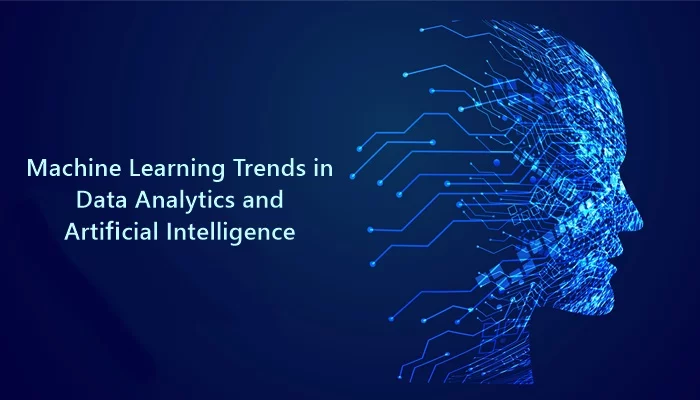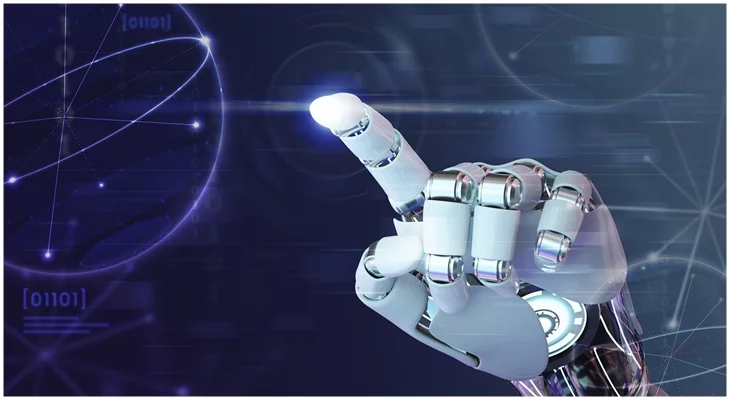What is Machine Learning
Machine learning means teaching machines to interact with humans or as humans. Programming is done so that the computer can respond or understand like a human mind. Machine learning is an essential part of AI that is designed to make the system learn on its own and adapt itself accordingly. For example, it can make the system learn to read the program on its own without the programmer's coding. Machine Learning and Artificial Intelligence have started a trend in the tech industry. The Machine Learning trends in Data Analytics have become much more critical for companies to survive in today's technologically advanced environment.
Machine learning deals with data mining and predictive modeling. Machine learning takes some data to understand the patterns and then uses that pattern to make predictions about new situations. Human interaction is needed to provide the machine with the required data.
Machine Learning is a scientific study of algorithms and data models that are used to perform a particular task without giving explicit instructions to a computer. Machine Learning patterns and interfaces are used in this process.
- Machine Learning Trends in Data Analytics
- Linking of ML and IoT
- Automated Machine Learning
- Machine Learning in Cyber Security
- The Rise of AI Ethics
- AI Engineering
- Transformation of Business Intelligence with Augmented Analytics
- The Emergence of No-code AI
- AI/ML Enabled Smart Manufacturing
- AI-Powered Automation and Innovation
- Upcoming of Responsible AI
Machine Learning Trends in Data Analytics
Following are some of the trends in Data Analytics, Machine Learning & Artificial Intelligence.
Linking of ML and IoT
IoT is already established technology. In IoT, multiple devices are connected to a network, and they can communicate with each other. These devices continue to grow at a fast pace. All these smart devices collect data that can be analyzed and studied to gain valuable insights. This is when machine learning comes in handy. Machine learning algorithms are used to convert the data collected by IoT devices into useful, actionable results.
The linking between ML and IoT can also be applied in the field of smart vehicles. Self-driving vehicles need to be extremely precise, with every part communicating with each other in milliseconds on the go.
Automated Machine Learning
The next stage of development is Automated Machine Learning. Automated Machine Learning is a boon for people who are not experts in the complex world of machine learning. It makes things easier for experienced data scientists and analysts. Automated machine learning allows data scientists to build machine learning models with high efficiency and productivity with the highest quality.
Automated Machine Learning can be used to train high-quality custom machine learning models. These models can be used for classification, regression, and clustering without much knowledge of programming. Without much complex workflow of machine learning, it can efficiently deliver the right amount of customization without a detailed understanding. Automated Machine Learning can also help to utilize machine learning best practices while saving time and resources.
Machine Learning in Cyber Security

Machine learning is also being used to create smart antivirus software. This smart antivirus software can detect any virus or malware by its unusual behavior. The smart antivirus software can identify old threats from viruses already encountered and new threats from viruses created recently by analyzing their behavior. Many companies such as Chronicle, Alphabet are integrating machine learning into cybersecurity.
The Rise of AI Ethics
With the rise of AI and ML, it has become essential to discuss the ethics of these technologies. Just creating a tech that is intelligent and has the ability to think independently is not enough. What if a self-driving vehicle kills a person? What if the machine learning algorithm is biased towards a specific group of people because the data is biased? What will happen to jobs if machine learning becomes more widespread? These are all questions of ethics that are important and need to be discussed.
There have already been many controversies, such as when Amazon learned in 2018 that their machine learning-based recruitment algorithm was biased against women. This happened because it was trained on data where most of the candidates were males, so the algorithm favored males over females.
AI Engineering
Just like software engineering, AI engineering is emerging as a profession. Moreover, AI Engineering is a significant development as the integration of artificial intelligence and machine learning in the industry has been growing.
Transformation of Business Intelligence with Augmented Analytics
Augmented Analytics uses AI and ML tech for data preparation, insight creation, and clarification. AI is proving to be an essential enabling tech, and enterprises need an efficient way to enhance their AI practices and apply AI to business. Business Intelligence teams need to develop and manage Artificial Intelligence and Machine Learning models to better optimize workflows.
The Emergence of No-code AI
Organizations worldwide are investing in tech that can help them accelerate the data science process as the need for AI applications grows. These no-code platforms are visual drag-and-drop tools that help make AI easier for non-technical people. However, despite simple workflows being easy to build and implement, they quickly become cumbersome and create a new set of challenges of their own. Organizations need to seek out more sophisticated AutoML platforms that enable no-code end-to-end automation.
AI/ML Enabled Smart Manufacturing
The COVID-19 crisis disrupted the supply chain and crushed small and medium businesses. There are shortages in grocery stores, and essential items were running out of stock. Manufacturers urgently need to be more flexible and transform operations using advanced technologies. With streaming analytics, manufacturers can make smart decisions with real-time applications. These smart decisions may include predicting supply chain disruptions or preventing unplanned downtime. Sensors and real-time quality monitoring could significantly reduce product recalls. The interlinking between AI/ML, real-time analytics, IoT can make manufacturing more efficient, flexible, and agile.
AI-Powered Automation and Innovation
AI can optimize organizational efficiencies, generate deep data-driven insights, and automate business decision-making. AI and ML can be embedded in multiple business functions to increase efficiencies and create new products and services. The availability of automated ML platforms makes it possible for organizations to quickly and efficiently implement AI.
Upcoming of Responsible AI
A focus on bias in AI, regulatory and privacy requirements make way for transparency in AI and ethical AI practices. As more organizations adopt AI in their business processes, there are concerns and risks regarding the automated decisions of the ML/AI model. These interpretable features keep organizations accountable for their data-driven decisions and meet compliance requirements.
Conclusion
The vast amount of data available to us is constantly increasing. Machines use this data to learn and improve the results and outcomes provided to us. These results can also be beneficial in providing valuable insights and making informed business decisions. Machine learning is growing continuously, and so are the applications of machine learning. We use machine learning in our daily lives much more than we know. In the future, machine learning is only said to move forward and help us. These Machine Learning trends in Data Analytics have become much more critical for companies to survive in today's technologically advanced environment.
You may like to read:
Machine Learning Vs. Artificial Intelligence
Current trends in Business Intelligence and Analytics
Artificial Intelligence Applications In The Food Industry
Applications of Deepfake Technology: Positives and Dangers
What Is A Deep Learning Framework: Top 10 Frameworks





